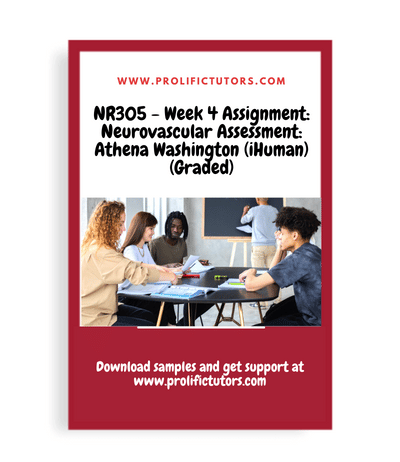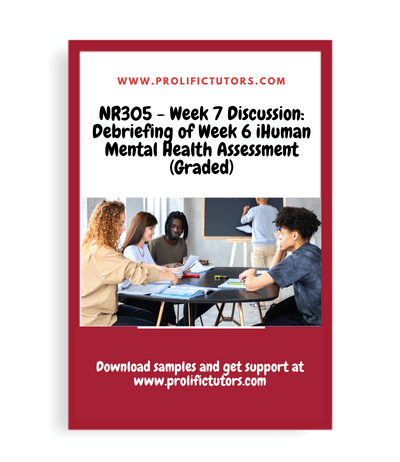Description
——————-
Best Value Deal – Your purchase includes a choice of 10 discussion responses that you can choose from.
——————-
Required Resources
Read/review the following resources for this activity:
- Textbook: pp. 402-422.
- Lesson
- Minimum of 1 source from the textbook
Apply the following writing resources to your posts:
- Link (website): APA Citation and Writing
Main Post: Share “Good to Great” Techniques You Picked up in Your Textbook Readings
To begin, look over the readings (sample essays/articles) of the text. Read as many as you’d like; you do not need to choose just one. You are not evaluating one essay in this discussion (although you may work with just one if you would like). Rather, you are evaluating argument techniques, effective word choice and transitions, the author’s voice, and the development of points with evidence. Not everything in these readings will be relevant for you; it is your job to find those powerful gems of wisdom that make you think, “Yes! I can apply this same technique!”
So, as you look through the readings and choose single items and sections to focus on, take your own notes and jot down your own thoughts before writing and posting your formal response to the following:
Quote one exact passage from a reading explaining the technique that appealed to you. This may be a particular use of logic, the way an author puts flair on a synthesis of support and opposition, a transition technique you had not considered, the way an author discusses (concedes and refutes) an opposing viewpoint, how an author drives the writing with voice, or any argument technique that “spoke to you.” Next, explain in as much detail as possible how you will use this technique in your own argument research essay. Which portion of your essay and/or with which source? How will you apply it to strengthen your essay?
Example structure:
- Quotation: (quote, cite in-text, and include at the end of your post a full reference)
- Technique that appealed to you in this quotation and why (being as detailed as possible).
- How you will use the technique: Be very specific and detailed, explaining exactly where in your essay you would like to use it, in which section, with sources, for voice, for anything that contributes to the effectiveness of your essay.
Example:
Quotation 1: McCloskey (2016) asserts: “In any case, the problem is poverty, not inequality as such—not how many yachts the L’Oréal heiress Liliane Bettencourt has, but whether the average Frenchwoman has enough to eat” (p. 499).
Technique that appeals to me: The technique that appeals to me in this passage is the stark contrast between rich and poor and the very specific example, not just of rich people, but of a specifically named rich person. This appealed to me because seeing an author paint a picture in my own mind helped me to understand that I can easily improve my essay with this simple technique. I also love the transition here and the clarification of the problem. It’s a good transition to show a shift to what really matters, and I hadn’t thought about defining what the problem “is” and “is not.”
How I will use the technique in my draft: I will use this technique in a few places in my essay where I give general examples but could be much more powerful for my reader by offering something precise. One particular point in my essay addresses the problems some people have with no transportation to local clinics. In my essay, I wrote, “Consider, for example, those single mothers who cannot afford a vehicle and whose hands are tied when their children suddenly become very ill.” To apply McCloskey’s technique, I might instead say, “Consider, for example, the single mother who lives five miles from the nearest local clinic. Her three-month-old baby suddenly spikes a fever of 101 degrees, she has no car, all of her relatives live in other states, and it is below freezing outside.” In addition, I looked for places in my essay in which I could use this stronger transition and definition of problem technique. I found in my third paragraph, this: “If a clinic is more than a mile away, walking there with a child is an unreasonable expectation but necessary.” I realized that while this is a good argument, I could make it clear that distance is not the central issue, like McCloskey did with inequality. My idea for adding clarity is: “However, precise distance is not the key concern; the real concern is the peace of mind that local access brings to families.” I’m still working on the wording of this, but I will definitely apply this technique.
Reference for source used in this example:
McCloskey, D. N. (2016). The formula for a richer world? Equality, liberty, justice and wealth. In S.U. Seyler, & A. Brizzee (Eds.), Read, reason, write: An argument text and reader. (pp. 497-502). McGraw-Hill.
Follow-Up Post Instructions
Respond to at least one peer. Here, in reading others’ posts and replying to them, you will learn a great deal more about approaches to composing good argumentative points and about the passion and the person behind your classmates’ stances. In your follow-up posts, please share your thoughts on your classmates’ analysis of the textbook reading and respond to their personal reflections with substance.
Writing Requirements
- Minimum of 2 posts (1 initial & 1 follow-up)
- Minimum of 2 sources cited (assigned readings/online lessons and an outside scholarly source)
- APA format for in-text citations and list of references
Grading
This activity will be graded using the Discussion Grading Rubric. Please review the following link:
- Link (webpage): Discussion Guidelines
Course Outcomes (CO): 6, 7
Due Date for Initial Post: By 11:59 p.m. MT Recommended by Wednesday
Due Date for Follow-Up Posts: By 11:59 p.m. MT on Sunday
Posts must be on two separate days.

![[Solved] ENGL147N - Week 5 Discussion- “Drop the Microphone”- Examine Examples toward More Compelling Argument Essay](https://prolifictutors.com/wp-content/uploads/2023/01/Solved-ENGL147N-Week-5-Discussion-Drop-the-Microphone-Examine-Examples-toward-More-Compelling-Argument-Essay-.png)


![[Top Answer] MATH225N - Week 2 Assignment - Frequency Tables - MATH225N Statistical Reasoning for the Health Sciences](https://prolifictutors.com/wp-content/uploads/2022/07/Top-Answer-MATH225N-Week-2-Assignment-Frequency-Tables-MATH225N-Statistical-Reasoning-for-the-Health-Sciences.jpg)
![[Top Answer] MATH225N - Week 3 Assignment - Measures of Central Tendency - MATH225N Statistical Reasoning for the Health Sciences](https://prolifictutors.com/wp-content/uploads/2022/07/Top-Answer-MATH225N-Week-3-Assignment-Measures-of-Central-Tendency-MATH225N-Statistical-Reasoning-for-the-Health-Sciences.jpg)


Reviews
There are no reviews yet.